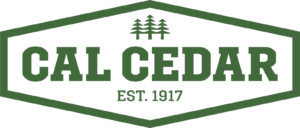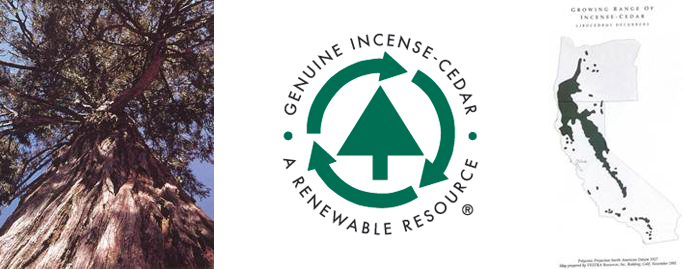Genuine Incense-cedar is sustainably managed to assure long term renewable supplies of this premium raw material
Incense-cedar is a hearty, drought-tolerant species that grows in a variety of soils in abundance throughout it’s natural growing range of the inland forests of central and northern California (as Calocedrus decurrens) and in southern Oregon (as Libocedrus decurrens). Though widely distributed in elevation it flourishes within the 2,000 to 6,900 foot (610 to 2,100 meter) elevation range.
Unlike species that occur in pure stands, Incense-cedar can be found scattered among Douglas-fir, Jeffrey Pine, ponderosa pine and other species that dominate the mixed-conifer forest. Incense-cedar generally comprises about 5% of the trees in a stand throughout its growing range. Despite its popularity in a range of uses, Incense cedar has never become a mono-cultural plantation species as with other commercial western softwoods. As a prolific seed-cone producer it readily regenerates and proliferates throughout it’s growing range aggressively repopulating any available site on the forest floor. It’s germination and survival rate are excellent relative to other softwoods.
Even with the strong natural regeneration of Incense-cedar and the fact that it is not typically considered one of the more important commercially managed species, managed reforestation of the species is practiced by both governmental agencies and private interests. There are nurseries which grow Incense-cedar saplings for both reforestation and ornamental use purposes. Historically, significant research has also been carried out on such issues as genetic diversity, adaptability, insect resistance and survivability with respect to Incense-cedar. The application of the knowledge gained through years of research assures improved forest health and a continued sustained availability of Incense-cedar.
Incense-cedar originally began to be used as a substitute wood for Eastern Red Cedar (Juniperus virginiana) which was the premier wood for US produced pencils and some European pencils dating from the mid 1800s through the early 20th century. The first Incense-cedar slat production facility was built by Hudson Lumber Company, a subsidiary of Eagle Pencil Company (seeOur History to learn about the family connection between CalCedar and Eagle Pencil Company). Completed in 1910, Hudson’s San Leandro, California facility was established to take advantage of the plentiful lower cost supply of California Incense-cedar from Western forests and more importantly of the unique technical wood properties of this species when applied to pencil manufacturing.
What about these unique technical properties? First, Incense-cedar exhibits optimal physical characteristics for close-tolerance, precision machining that make for very smooth machined surface and exceptional sharpenability in finished pencils as well as allowing optimal wood utilization from saw log, to pencil stock lumber, pencil slats and then into pencils. Additionally, it’s thermal conductivity rating or (K factor) is among the best for all softwoods. This provides dependable, predictable insulating properties and resistance to heat migration which positively impact performance of the species under machining conditions as well as gluing and drying. As one of the most stable wood species Incense-cedar also stands up to wider variations in temperature and humidity without warping, checking or shrinking. This allows for tighter size tolerances and easy shipment to and use of cedar by pencil factories in many regions of the world where there are varying climates. Finally, the smoothly machined surface and relative lack of resin canals and pitch pockets assure that cedar pencils can be easily painted or stained with lacquer or water based stains to a fine, smooth finish.
Soon after Hudson’s San Leandro facility began operation a number of sawmill and pencil slat manufacturing facilities were built in California to meet the growing need and demand for this species from the pencil industry. California Cedar Products Company was established in 1919 and acquired by present owners in 1927 and eventually became the leading producer of California Incense-cedar slats. In addition Incense-cedar proved to be particularly suitable for use in a number of other premium quality wood products including high quality siding and decking, fencing, interior paneling and mouldings, window shutters, and even appearance grade timbers. Over the years California Cedar Products and its sister company P&M Cedar Products developed the market for many of these items proving that the optimal utilization of the species involved a balanced mix of products. Our specialization in these products eventually resulted in CalCedar surviving as the last producer of such slats in California before the relocation of slat manufacturing to our Tianjin, China facility in 2001 due to global competitive developments.
Despite the fact that more Incense-cedar is growing in Western U.S. Forests than ever before, Incense-cedar now serves primarily the premium end of the market. Incense-cedar use for pencils has declined due to comparative economics with other species as well as a combination of regulatory developments in western forests, declining housing construction in the U.S., and diameter class changes which serve to reduce the total harvest volumes from historical levels. These factors restrict availability for pencil market use regardless of the fact that Incense-cedar growth rates exceed the consumption rates for all uses of Incense-cedar wood fiber. As various market demand conditions change there will always be movement along the margins between alternative uses for cedar and total harvest levels. However it’s anticipated that Incense-cedar can and will remain the premier wood species for production of premium quality pencils with a long term sustainable supply.
Today some pencils are being marketed as made of Cedar, but in fact are produced from non-cedar species that offer inferior performance and generally less sustainable harvesting conditions. Since the mid 1990’s in order to protect the reputation of quality and sound environmental management of Incense-cedar, CalCedar® brand slats are marketed with the “Genuine Incense-cedar”® mark. The “Genuine Incense-cedar” ® mark is available under license to CalCedar slat customers using our slats exclusively in the production of their cedar pencils. Look for and insist on the “Genuine Incense-cedar” ® mark when purchasing cedar pencils to be assured of the highest quality, reliability and sound ecological management standards.
For further information on the history of the transition of pencil wood consumption from Eastern Red Cedar to California Incense-cedar visit the Timberlines blog post “Why Incense cedar?”


